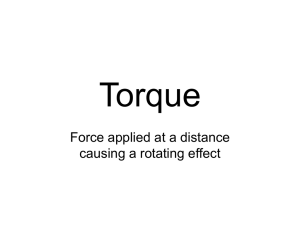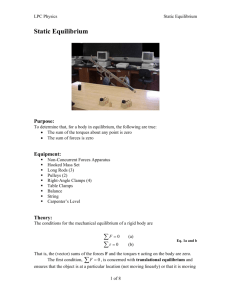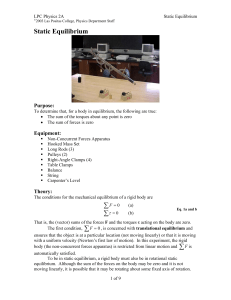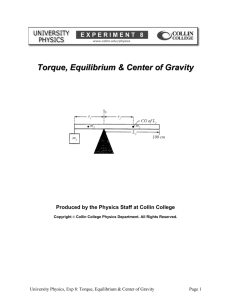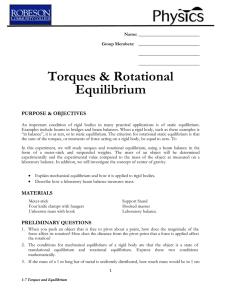EQUILIBRIUM, BALANCE, AND STABILITY
advertisement
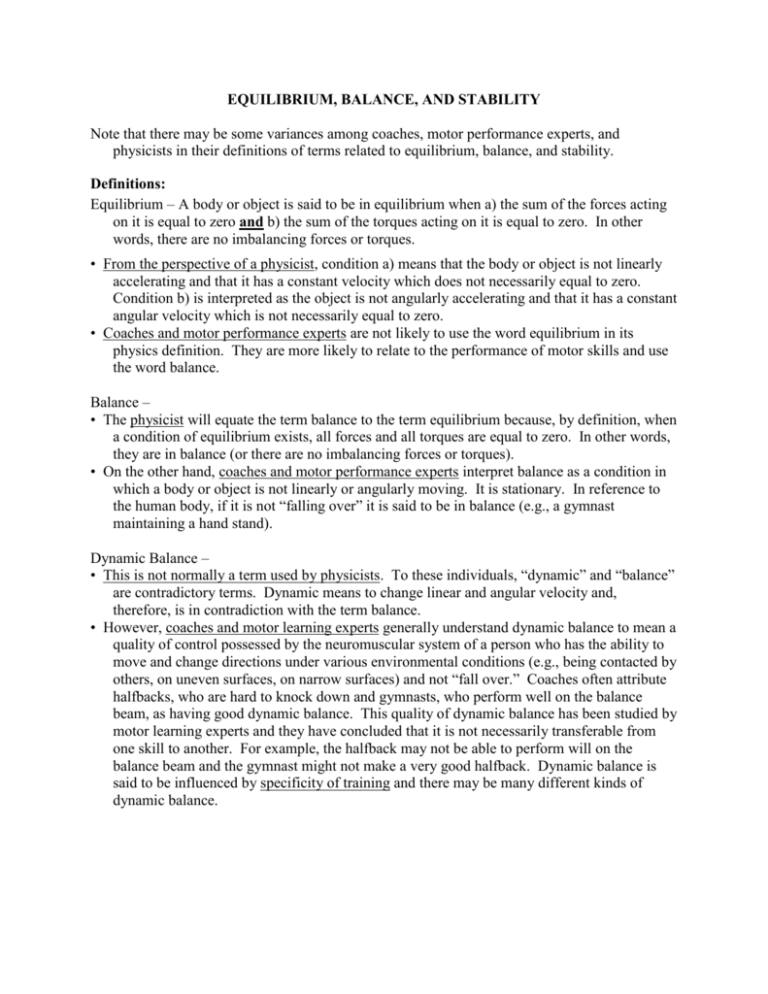
EQUILIBRIUM, BALANCE, AND STABILITY Note that there may be some variances among coaches, motor performance experts, and physicists in their definitions of terms related to equilibrium, balance, and stability. Definitions: Equilibrium – A body or object is said to be in equilibrium when a) the sum of the forces acting on it is equal to zero and b) the sum of the torques acting on it is equal to zero. In other words, there are no imbalancing forces or torques. • From the perspective of a physicist, condition a) means that the body or object is not linearly accelerating and that it has a constant velocity which does not necessarily equal to zero. Condition b) is interpreted as the object is not angularly accelerating and that it has a constant angular velocity which is not necessarily equal to zero. • Coaches and motor performance experts are not likely to use the word equilibrium in its physics definition. They are more likely to relate to the performance of motor skills and use the word balance. Balance – • The physicist will equate the term balance to the term equilibrium because, by definition, when a condition of equilibrium exists, all forces and all torques are equal to zero. In other words, they are in balance (or there are no imbalancing forces or torques). • On the other hand, coaches and motor performance experts interpret balance as a condition in which a body or object is not linearly or angularly moving. It is stationary. In reference to the human body, if it is not “falling over” it is said to be in balance (e.g., a gymnast maintaining a hand stand). Dynamic Balance – • This is not normally a term used by physicists. To these individuals, “dynamic” and “balance” are contradictory terms. Dynamic means to change linear and angular velocity and, therefore, is in contradiction with the term balance. • However, coaches and motor learning experts generally understand dynamic balance to mean a quality of control possessed by the neuromuscular system of a person who has the ability to move and change directions under various environmental conditions (e.g., being contacted by others, on uneven surfaces, on narrow surfaces) and not “fall over.” Coaches often attribute halfbacks, who are hard to knock down and gymnasts, who perform well on the balance beam, as having good dynamic balance. This quality of dynamic balance has been studied by motor learning experts and they have concluded that it is not necessarily transferable from one skill to another. For example, the halfback may not be able to perform will on the balance beam and the gymnast might not make a very good halfback. Dynamic balance is said to be influenced by specificity of training and there may be many different kinds of dynamic balance. Stability – • According to the physicist, an object or body is either stable or unstable. There are not intermediate levels of stability. In other words, it is either in balance (sum of the forces and torques are equal to zero) or not (sum of the forces and torques are not equal to zero). • According to coaches and motor learning experts, there are different levels of stability which depend on the mass and mass distribution of the object or body and also on the potential of the neuromuscular system to respond and counter disruptions to its stability (i.e., attempts to knock it over). These concepts are very important in the learning and performance of sport and motor skills and can be explained by Five Principles of Balance and Stability. Center of Gravity – Every particle that makes up an object experiences a downward force of gravity toward the center of the earth. The sum of this force is the object’s weight. If a support is placed directly below (or above) the center of mass distribution of an object or body, it will balance. Therefore, sometimes the center of gravity is referred to as the balance point. Line of Gravity – This is an imaginary straight line passing through the center of gravity of an object and the center of mass of the earth. Base of Support – It is the area formed by a perimeter around the supporting parts of an object in balance on a surface. For example, it is the area of the imprint of a shoe on a mat in a one foot balance. If a person is balancing on two feet, the base of support is the area of the imprints of both shoes and the surface space between them. Five Principles of Balance and Stability The five principles that follow are stated in terms of enhancing balance and stability. However, they could also be stated in terms of reducing balance and stability, thus, enhancing the potential for mobility. In sport and physical activity, there are times when an individual wants to a) increase or decrease his or her own stability or b) increase or decrease the stability of someone else. 1. For balance to exist, the line of gravity must intersect the base of support. Examples: 2. If the area of the base of support of an object is increased, this tends to increase the stability of the object. Examples: 3. The lower the center of gravity is above the base of support the more stable the object tends to be. (This is true even though the size of the base of support is unchanged.) Examples: 4. Objects that are more massive tend to be more stable. Examples: 5. For an object, the farther the line of gravity’s intersection is from the edge of its base of support the more stable the object tends to be in that direction. Examples:
